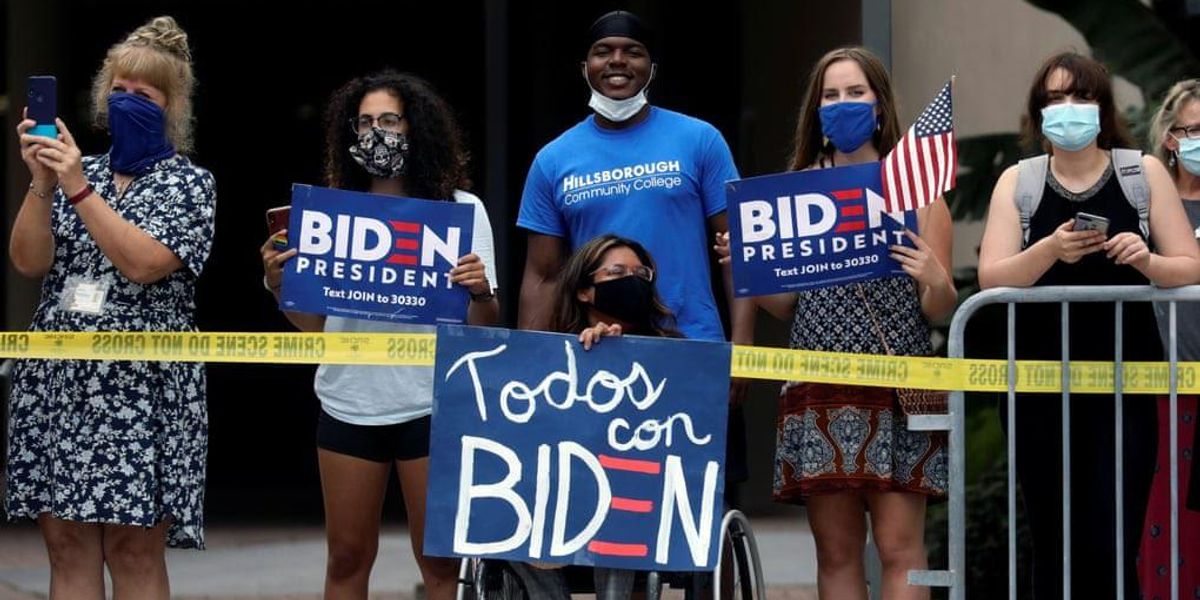
During the 2020 Election, Latino voters showed up in record numbers. Most of them, 66%, cast their ballot for President-Elect Joe Biden. Despite these statistics, the mainstream media has crafted a narrative that blames an imagined homogenous Latino voter bloc for the Democratic nominee’s loss in key battleground states, like Florida and Texas.
Political analysts, journalists, and historians will study this election cycle for years to come. But in current examinations, groups of color, and Latino voters in particular, have been the subject of focus. On November 4, the day after the historic election, The Washington Post published an article that looked at how Latinos helped “sink Biden in Florida.” That same day, local papers in Texas hinted that Latino voters in the state handed the win to President Donald Trump.
These analyses, which have been regurgitated across national news outlets, fail to examine the white vote, the only racial group in which a majority voted for Trump. For many, the media’s efforts to pick apart the voting patterns of Latinos have led to a cultural indictment of the demographic and a pass to whites.
“The overall fixation on Latinos is a scapegoat,” Rep. Alexandria Ocasio-Cortez (D-N.Y.) told POLITICO. “Because what’s implicit in that is the assumption and the entitlement that a hundred percent of communities of color must turn out for Democrats and anything less is a failure while we just … allow us to lose vast majorities of white voters without any introspection.”
It must also be noted that Latinos were not targeted by Democrats the way white voters, who were the focus of expensive political organizing campaigns, were. Despite this snub, it’s Latino voters, and not whites, who continue to be examined and slighted by the press.
“Why is it that Latinos had become such a target for their voting preferences when they were overlooked by [Democrats],” Antonio Arellano, the interim executive director of Jolt, a grassroots organization focused on building Latinos’ political power in Texas, told AJ+.
Concerns like Arellano’s are valid. Despite Trump launching his presidential campaign in 2015 by calling Mexicans “rapists” and centering his presidency on anti-immigration policies, the president did intentionally and effectively target Latino communities while on the campaign trail. Trump made specific outreach to Cuban and Venezuelan voters in South Florida, and he recognized the specific concerns, like gun rights and the oil and gas industries, of Mexican Americans in South Texas. Unlike Trump, Biden’s camp released delayed Spanish-language ads that treated the demographic like a monolith as well as a last-minute Hispandering act when he played Luis Fonsi’s Despacito at a Hispanic Heritage Month event.
Despite being an afterthought to the Democratic Party, Latino voters still, overwhelmingly, supported Biden at the polls. Biden won more of the nationwide Latino vote than Hillary Clinton did in 2016. But this is largely due to grassroots organizations, like the New Florida Majority, Mijente, Jolt, Lucha AZ, Mi Familia Vota, and more, that worked throughout the country doing what Biden’s camp failed to accomplish: knocking on doors, registering hundreds of thousands of people to vote, educating them on the voting process, and encouraging them to turn out.

These organizations didn’t just target Latinos but they also understood the demographic as a heterogeneous population and crafted messaging around the different groups’ varying needs. While it shouldn’t have to be said again, here it goes: Latino voters are not a single bloc. The population is made up of nearly 60 million people who represent more than 20 origin countries.
Among them, there are people of different races, classes, languages, religions, immigration statuses, and reasons for migrating to the United States. Even more, these disparate groups are spread out throughout the country and have multiple regional concerns as well.
When the media makes inaccurate claims that Latino votes in Florida and Texas gave these states to Trump, they’re not only absolving a white majority that voted for the president but they’re also attempting to homogenize a heterogeneous group by identifying a massive voting bloc by the ballots cast by a smaller few. For instance, Texas’ Rio Grande Valley, a transborder region that’s composed largely of Latinos, did mostly vote for Trump. However, this region accounts for just 15% of the Latino vote in Texas. Across the state’s major cities, like San Antonio and Houston, which are also home to a great number of Latinos, the demographic largely voted for Biden.
Similarly, reports about the Florida Latino vote almost exclusively look at Latino voters in South Florida, where large pockets of Cubans, Venezuelans, Colombians, and Nicaraguans voted for Trump. However, these articles fail to reflect the substantial numbers of Latino voters in Central and North Florida who cast their ballot overwhelmingly for Biden. In Florida, more Latinos voted for Biden than for Trump.
Even in hyperlocal reporting, the analysis is often incomplete. While mainstream outlets tend to focus on South Florida Cubans, who have for decades leaned Republican, few recognize the ruptures that exist within this demographic.
“Within our own families, there are a lot of different positions and perspectives. But this complexity isn’t visible because the Cuban-American identity has become synonymous with conservatism and republicanism,” Ana Sofía Peláez, co-founder of the Miami Freedom Project, told Luz Collective last month. This year, 57% of Florida Cubans voted for Trump, while 40% voted for Biden, which shows the Florida Cuban-American voting bloc is more split, largely between an older generation and their younger offspring, than many analysts care to mention.
If media outlets are surprised by Latino voting diversity, it’s because they neither understand the demographic nor care to read the abundance of research already done by Latino scholars and journalists who have long, and especially during this election year, stressed the complexity of Latino identity, culture, history, experience, and the consequent voting patterns. Even more, if outlets, and liberal talking heads, in particular, continue to place blame on Latino voters, who despite being disregarded by Democrats still predominantly voted for Biden, they risk pushing the demographic away even further.














 Photo by
Photo by 



















